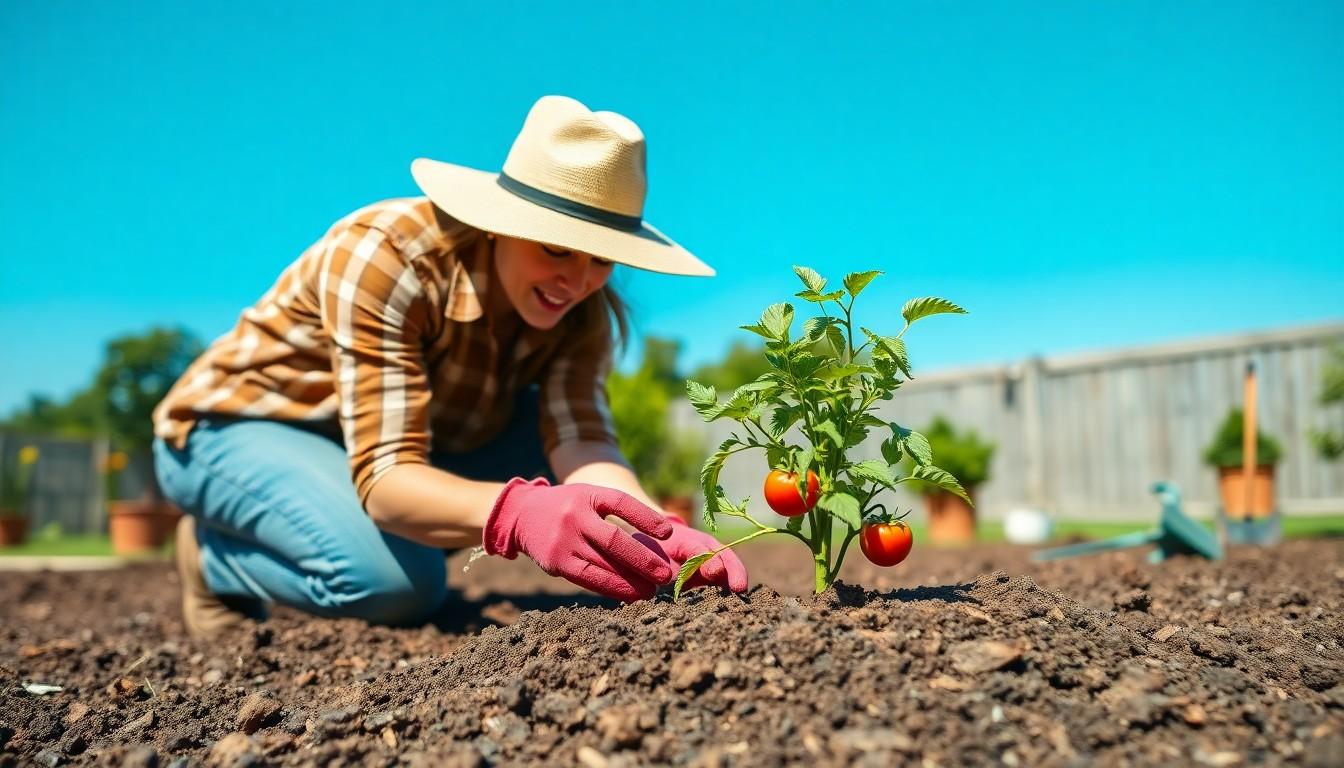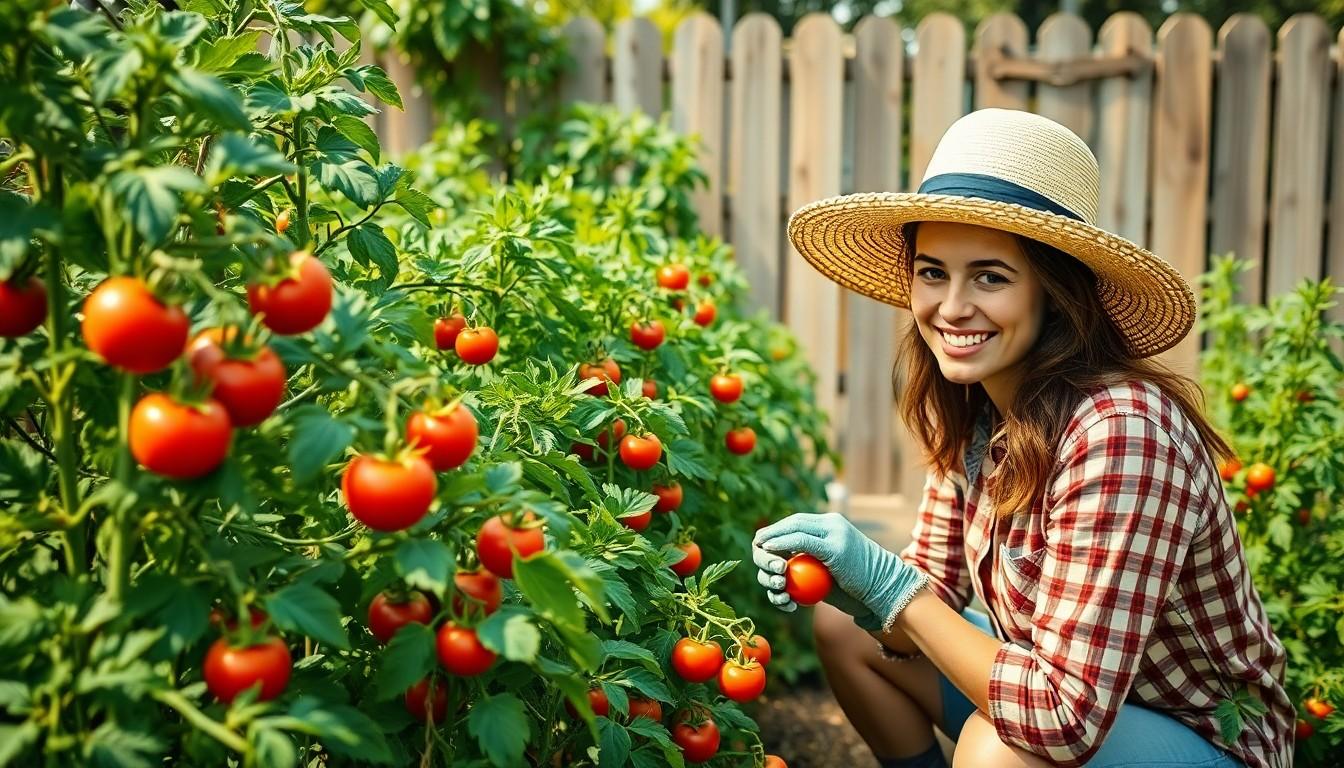Growing a tomato plant can feel like a culinary adventure right in your backyard. Imagine plucking ripe, juicy tomatoes fresh from the vine, ready to elevate your salads and sauces. But before you dive in, remember that these little green wonders need more than just sunshine and a prayer.
Caring for a tomato plant is like nurturing a diva—give it attention and it’ll reward you with a bountiful harvest. From selecting the right variety to mastering watering techniques, each step is crucial for turning your gardening dreams into reality. So grab your gardening gloves and let’s dig into the essential tips that’ll keep your tomato plant thriving and your kitchen stocked with deliciousness. Who knew growing tomatoes could be this fun?
Essential Requirements for Tomato Plants
Successful tomato growth hinges on meeting their essential requirements. Careful attention to variety selection and soil conditions promotes healthy plants and abundant yields.
Choosing the Right Variety
Selecting the right tomato variety significantly impacts growth and harvest. Determinate varieties, like ‘Roma’ tomatoes, grow to a specific size and produce fruit simultaneously, perfect for canning. Indeterminate varieties, such as ‘Cherokee Purple’, continue growing and producing fruit throughout the season, ideal for fresh eating. Consider local climate conditions when choosing. Heat-tolerant types excel in warmer areas, while cold-resistant varieties thrive in cooler climates. Assess flavor preferences, as certain varieties offer sweetness while others provide tartness. Start with heirloom varieties for unique flavors and increased biodiversity.
Understanding Soil Needs
Tomato plants thrive in well-drained, nutrient-rich soil. Testing soil pH before planting ensures it’s between 6.0 and 7.0, a range that enhances nutrient absorption. Mix organic matter, such as compost, into the soil to improve fertility and structure. Maintaining good drainage prevents root rot, a common issue in overly saturated soils. Incorporating mulch around the base helps retain moisture while reducing weeds. Adding fertilizers high in potassium encourages fruit development. Regularly monitoring soil moisture levels supports healthy root systems and prevents stress on plants.
Planting Your Tomato Plant

Planting a tomato plant involves careful consideration of its environment and planting method. Proper planning leads to healthy growth and abundant harvests.
Selecting the Optimal Location
Choosing the right spot is crucial for tomato plant success. Areas with full sunlight provide at least six to eight hours of direct light each day. Additionally, good air circulation prevents fungal diseases. Look for locations with rich, loamy soil that drains well and isn’t prone to standing water, as this can lead to root rot. Avoid areas where previous tomato plants grew to reduce disease risk.
Planting Techniques and Depth
Seeding tomatoes at the correct depth promotes robust growth. Dig holes about 18 to 24 inches apart, allowing for proper air circulation. Ensure the holes are deep enough to accommodate both roots and the stem, planting it up to the first set of true leaves. Covering the stem encourages rooting and provides additional stability. Water the plants thoroughly after planting to help them settle into their new environment.
Watering and Nutrition
Watering and nutrition are vital for growing healthy tomato plants. Correct practices ensure plants thrive and produce abundant fruit.
Best Practices for Watering
Watering deeply and consistently helps establish robust root systems. Aim for soil moisture of one to two inches per week, adjusting based on weather conditions. Early morning is the best time for watering, as it minimizes evaporation and fungal disease risk. Avoid watering leaves to prevent disease and promote healthy growth. Using soaker hoses or drip irrigation allows for efficient water delivery to the roots, ensuring even moisture levels. Additionally, check soil moisture by inserting a finger about an inch deep; if it feels dry, it’s time to water.
Fertilizing Your Tomato Plant
Fertilizing guarantees tomato plants receive essential nutrients for growth. Start with a balanced fertilizer, such as a 10-10-10 mix, for initial growth stages. As plants begin flowering, switch to a fertilizer higher in potassium to support fruit development, like a 5-10-10 mix. Applying fertilizer every four to six weeks maintains nutrient levels. Additionally, organic options like compost or aged manure enrich soil fertility and improve structure. Always follow package instructions to prevent over-fertilization, which can harm plants and hinder fruit production.
Pest and Disease Management
Managing pests and diseases in tomato plants ensures a healthy and fruitful garden. Awareness of common issues and preventive measures helps safeguard plants against potential threats.
Common Pests to Watch Out For
Aphids, spider mites, and whiteflies often infest tomato plants. Aphids suck sap from tender leaves, leading to wilting and stunted growth. Spider mites create fine webbing and cause yellowing of leaves, restricting photosynthesis. Whiteflies leave sticky residue and attract sooty mold, affecting plant health. Regularly inspecting plants for early signs of these pests allows for quick action. Implementing barriers like row covers and encouraging beneficial insects such as ladybugs or lacewings effectively reduces pest populations.
Preventing and Treating Diseases
Fungal diseases like blight and powdery mildew can devastate tomato plants. Blight manifests as dark spots on leaves and stems, often worsening in humid conditions. Powdery mildew appears as white patches, especially in crowded spaces with poor air circulation. Maintaining proper spacing between plants promotes airflow. Regularly removing infected leaves and using mulch helps prevent soil-borne diseases from splashing onto the plants. Applying fungicides may offer further protection, but following directions is crucial to avoid harming beneficial organisms. Monitoring weather conditions for ideal growing environments also plays a key role in disease prevention.
Harvesting Tomatoes
Harvesting tomatoes involves recognizing the right timing for optimal flavor and texture. Observing a tomato’s color, firmness, and size ensures the best harvesting experience.
When to Harvest
Timing is vital for harvesting tomatoes. Fruits typically ripen about 60 to 85 days after planting. Look for a rich color, which varies by variety, and slight softness when gently squeezed. Harvesting should occur once the tomatoes reach their mature color but before they start to wrinkle. For indeterminate varieties, continuous harvesting encourages further production. Checking for an even color around the stem helps determine readiness, while changes in the green top or stem can signal over-ripening.
How to Properly Harvest
Proper harvesting techniques enhance fruit quality and plant health. Use garden shears or scissors to cut the stem about one inch above the fruit, avoiding damage to the plant. Gently twist the fruit when pulling to ensure it detaches easily. It’s best to harvest in the morning when temperatures are cooler to reduce stress on the fruit. Place harvested tomatoes in a breathable container to prevent bruising. Avoid stacking them too high, as this can lead to damage. Storing them at room temperature allows for additional ripening if needed.
Conclusion
Growing tomato plants can be a fulfilling journey that rewards gardeners with delicious, homegrown produce. By understanding the specific needs of these plants and providing the right care, anyone can enjoy a bountiful harvest. From selecting the ideal variety to mastering watering and fertilization techniques, each step plays a crucial role in the overall success of the garden.
Staying vigilant against pests and diseases ensures the plants remain healthy and productive. With patience and attention to detail, the joy of harvesting ripe tomatoes becomes a delightful reality. Embracing this process not only enhances culinary experiences but also fosters a deeper connection with nature. Happy gardening!

